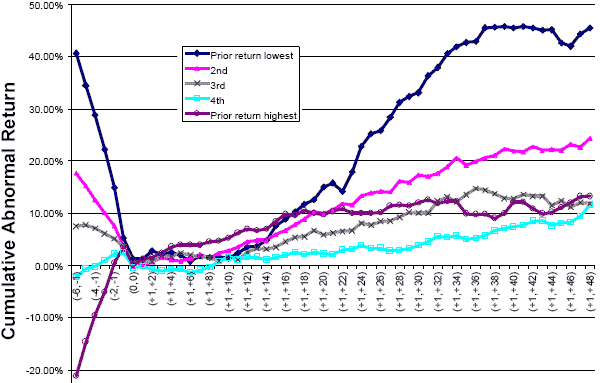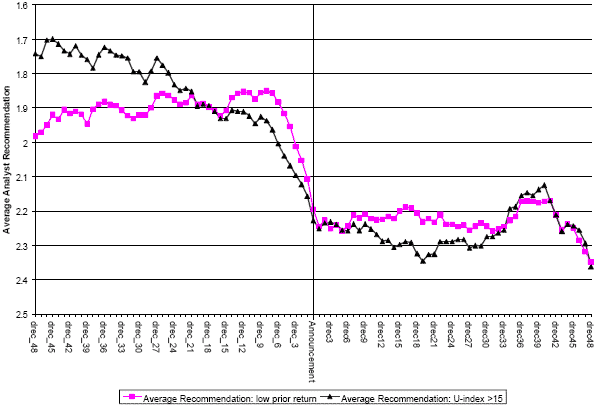Are stock buybacks still good indicators of future strong returns, or have investors driven this anomaly from the market? If they still work, why? In their January 2007 paper entitled “The Nature and Persistence of Buyback Anomalies”, Urs Peyer and Theo Vermaelen investigate whether market recognition has eliminated or attenuated the stock repurchase anomaly. Using a sample of 3,481 repurchase announcements spanning 1991-2001, they find that:
- Long-run excess returns after open market repurchases are as large and significant as ever, especially for value and small stocks. For the full sample, the cumulative average abnormal returns over 12, 24, 36 and 48 months after announcement are 2.7%, 10.5%, 18.6% and 24.2%, respectively.
- The 20% of buyback stocks with the highest (lowest) book-to-market ratios have an average cumulative abnormal return of 28.9% (14.9%) 48 months after announcement.
- Combining several measure of pre-announcement undervaluation, ten out of 11 portfolios consisting of the 50 most undervalued buyback stocks for each year during 1991-2001 yield 48-month excess returns of at least 40%.
- Significantly negative pre-announcement abnormal returns are the best indication of significantly positive post-announcement returns. The 20% of stocks with the worst (best) pre-announcement returns yield an average cumulative abnormal return of 45.4% (13.2%) 48 months after announcement.
- The average abnormal return in the three days around a buyback announcement is 2.4%. This short-term return is higher for firms citing “undervaluation” (3.7%) or “best use of money” (2.9%) or both factors (3.99%) as the reason for repurchasing shares. In contrast, this return is lower for firms citing “dilution” (1.4%) or “EPS management” (0.34%), but neither “undervaluation” nor “best use of money.”
- As a result of disappointing earnings, analysts significantly downgrade beaten up stocks around a buyback announcement, most notably during the buyback announcement month. The downgrades appear to be based on overly-pessimistic earnings forecasts, and the share repurchase announcement is essentially management’s repudiation of the downgrades.
The following chart, taken from the paper, segments the behavior of stocks around buyback announcements according to risk-adjusted returns in the six months before announcement. The 20% of stocks that are weakest during the six months before announcement show the greatest ultimate strength after the announcement.

The next chart, also from the paper, shows the behavior of average analyst recommendations for two subsamples of stocks involved in share repurchases from 48 months before to 48 months after the buyback announcement. The scale of recommendations is: 1=strong buy; 2=buy; 3=hold; 4=sell; 5=strong sell. The pink line represents the average recommendation for the 20% of stocks with the worst pre-announcement returns. The black line represents the stocks that are most extremely undervalued pre-announcement based on past performance, book-to- market ratio, size and the stated reason for the buyback.

In summary, share repurchase announcements persist as good indicators of stock undervaluation, most significantly amplified by poor returns over the prior six months.